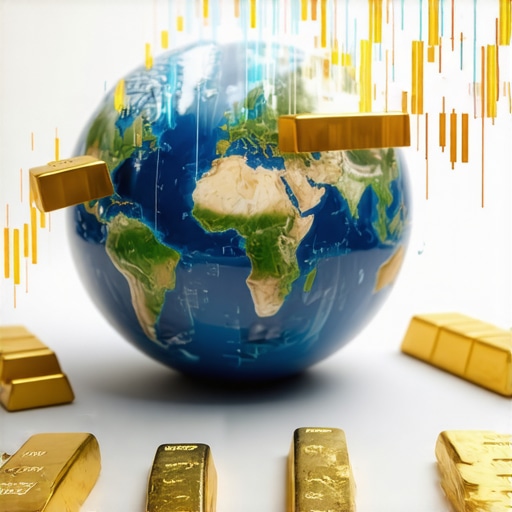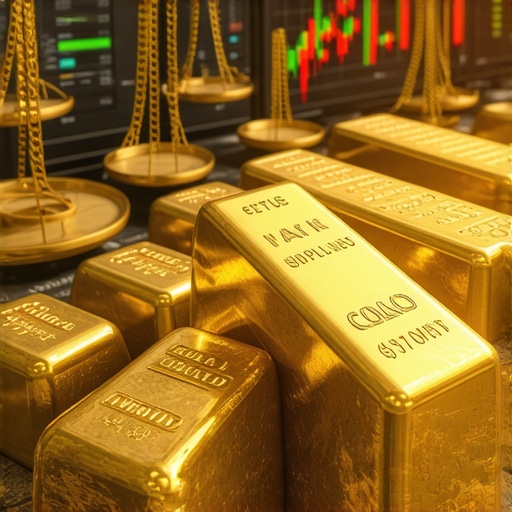Understanding the Nexus Between Global Economic Trends and Gold Price Dynamics in 2025
As an industry expert in precious metals investment, I recognize that the trajectory of gold prices in 2025 will be profoundly influenced by overarching global economic trends. These macroeconomic forces not only reflect current market sentiments but also serve as predictors for future price movements, demanding a nuanced understanding from serious investors and financial strategists alike.
Deciphering the Role of Geopolitical Stability and Economic Policies
Geopolitical tensions, trade disputes, and fiscal policies significantly sway gold prices. For instance, heightened geopolitical instability often prompts investors to seek safe-haven assets like gold, thus elevating its price. Conversely, expansive monetary policies aimed at economic stimulation can lead to inflationary pressures, which historically bolster gold as an inflation hedge, especially in 2025 where central banks are recalibrating their strategies amidst post-pandemic recovery efforts.
Impact of Inflation and Currency Fluctuations on Gold Valuation
Inflation rates, influenced by global monetary policy and supply chain disruptions, are critical in determining gold’s attractiveness. A sustained rise in inflation, coupled with weakening fiat currencies, tends to increase gold demand, thereby pushing prices upward. The interplay between the US dollar’s strength and gold prices is particularly salient, as a weaker dollar often correlates with higher gold valuations, a trend that market analysts anticipate will intensify in 2025.
How Will Central Bank Activities Shape Gold Market Supply and Demand?
Central banks worldwide are pivotal players in the gold market, with their purchasing and sales activities directly affecting supply-demand dynamics. As detailed in this comprehensive analysis, increased gold acquisitions by central banks may signal confidence in gold’s role as a reserve asset, potentially driving prices higher in 2025. Conversely, any significant offloading could exert downward pressure.
What are the implications of emerging digital currencies and fintech innovations on gold as a hedge?
This question reflects ongoing debates among experts regarding the future of gold in a rapidly digitizing financial landscape. While some argue that digital currencies could diminish gold’s role as a traditional safe haven, others posit that technological advances might integrate gold into new financial instruments, thereby sustaining its relevance.
For investors seeking to optimize their holdings, understanding these complex interactions is essential. Exploring strategies such as diversified portfolio allocation with ETFs, physical gold, and gold mining stocks can provide resilience against volatility. To deepen your knowledge, consider reviewing this guide on developing a diversified gold portfolio.
As the landscape evolves, staying informed through authoritative sources like the World Gold Council can offer valuable insights. For a detailed forecast based on market analytics, see expert predictions for 2025 gold prices.
Decoding the Impact of Global Economic Shifts on Gold Price Trajectories in 2025
As we analyze the intricate web of factors shaping the gold market in 2025, it becomes evident that macroeconomic developments—ranging from international trade policies to fiscal stimulus measures—play a pivotal role. Investors should pay close attention to emerging economic patterns, as these can serve as reliable indicators for future gold price movements, especially amid ongoing geopolitical uncertainties.
Will Technological Innovations Disrupt Gold’s Traditional Role as a Safe Haven?
One of the most compelling questions facing gold investors today is how digital transformation and fintech innovations will influence gold’s status as a financial safety net. Some experts suggest that the rise of digital currencies and blockchain-based assets could challenge gold’s dominance, potentially reducing its appeal during market turmoil. Conversely, advances in financial technology might integrate gold into new digital assets, reinforcing its relevance. For example, tokenized gold investments are gaining popularity, offering liquidity and accessibility that traditional physical gold investments cannot match. These developments necessitate a nuanced understanding of how emerging fintech solutions might reshape gold’s investment landscape in 2025.
What strategies should investors adopt to hedge against the evolving risks and opportunities in the gold market?
To navigate this complex environment, investors should consider diversifying their portfolios with a mix of physical gold, ETFs, and mining stocks, leveraging insights from authoritative sources such as the World Gold Council. Additionally, employing advanced analysis tools, like technical charting and supply-demand forecasting, can optimize entry and exit points. For practical tips, exploring guides on building a diversified gold portfolio can be invaluable. Staying ahead requires continuous education and strategic flexibility, particularly as global economic conditions evolve rapidly.
External sources like the Gold Price Forecast 2025 by industry analysts offer comprehensive insights grounded in market data and predictive modeling, helping investors make informed decisions. As the world economy shifts, understanding the nuanced interplay of these forces will be crucial for maximizing wealth preservation and growth through gold investments.
Leveraging Quantitative Models to Predict Gold Price Volatility in 2025
In the quest for precision, quantitative modeling offers a sophisticated toolkit to forecast gold price fluctuations amid complex global forces. Econometric techniques, such as vector autoregression (VAR) and machine learning algorithms, analyze vast datasets—including macroeconomic indicators, geopolitical events, and market sentiment—to generate probabilistic forecasts. According to a comprehensive study by the Journal of Forecasting, integrating these models enhances predictive accuracy, enabling investors to hedge effectively against anticipated price swings in 2025.
How can investors incorporate advanced analytics into their gold investment strategies?
By utilizing real-time data feeds and predictive analytics platforms, investors can identify emerging trends before they become apparent through traditional analysis. For instance, sentiment analysis of news and social media can reveal shifts in market perception, while stress testing portfolios against simulated economic shocks helps assess resilience. Supplementing these with quantitative signals from algorithms can refine timing for entry and exit points, ultimately optimizing risk-adjusted returns.
The Role of Environmental, Social, and Governance (ESG) Factors in Shaping Gold Market Sentiments
As ESG considerations become increasingly integral to investment decisions, their influence extends into the precious metals domain. Ethical sourcing, environmental impact of mining operations, and social responsibility initiatives are now scrutinized by institutional investors, potentially affecting supply-demand dynamics. A 2023 report by the World Gold Council emphasizes that transparent ESG practices can bolster market confidence, potentially stabilizing prices amidst global uncertainties in 2025.
Could ESG integration lead to a sustainable gold market, and how might this impact pricing?
Yes, ESG integration fosters long-term sustainability, which could reduce volatility caused by regulatory crackdowns or reputational risks. As demand for responsibly mined gold increases, premiums for ethically sourced products may emerge, influencing pricing structures. Investors who prioritize ESG factors can also benefit from enhanced transparency and reduced exposure to environmental liabilities, thus aligning financial gains with ethical imperatives.
Emerging Financial Instruments and Their Impact on Gold Liquidity and Accessibility
The evolution of financial instruments—such as blockchain-based gold tokens, fractional ownership platforms, and decentralized finance (DeFi) applications—are revolutionizing gold investment accessibility. These innovations lower barriers for retail investors, facilitate liquidity, and introduce new avenues for diversification. An insightful analysis by Finextra highlights that tokenized gold can seamlessly integrate into digital portfolios, offering real-time settlement and fractional ownership, which traditional physical gold cannot provide.
What are the potential risks and benefits associated with digital gold tokens in 2025?
Benefits include enhanced liquidity, transparency, and ease of transfer, making gold more accessible to a broader audience. Conversely, risks encompass regulatory uncertainties, cybersecurity threats, and technological vulnerabilities. Investors must conduct due diligence and select reputable platforms to mitigate these risks, ensuring that digital tokens serve as a reliable hedge amid evolving market conditions.
If you wish to deepen your understanding of these advanced strategies and technological innovations, exploring resources like the comprehensive guide to diversified gold portfolios is highly recommended. Staying informed through authoritative industry reports, such as those by the World Gold Council, empowers investors to navigate the complex, rapidly evolving landscape of gold investment in 2025 and beyond.
Harnessing Quantitative Analytics for Precise Gold Market Forecasting in 2025
Advanced investors and analysts are increasingly turning to sophisticated econometric models, such as vector autoregression (VAR) and machine learning algorithms, to decode the complex dynamics influencing gold prices. These tools analyze vast datasets encompassing macroeconomic indicators, geopolitical developments, and sentiment analysis, providing probabilistic forecasts that surpass traditional methods in accuracy. As highlighted in the Journal of Forecasting, integrating these models into investment strategies can significantly enhance risk management and timing precision for gold trades in 2025.
Expert Insights & Advanced Considerations
Strategic Diversification Is Key
In 2025, leveraging a diversified portfolio that combines physical gold, ETFs, and mining stocks remains a cornerstone for optimizing returns and mitigating risks amid volatile global markets.
Embracing Technological Innovation
The integration of blockchain-based gold tokens and digital assets is transforming accessibility and liquidity, making sophisticated investment strategies more attainable for both institutional and retail investors.
Monitoring Geopolitical and Economic Trends
Staying ahead involves closely analyzing geopolitical tensions, central bank policies, and macroeconomic indicators that influence gold’s safe-haven appeal and price movements.
Utilizing Quantitative and Predictive Analytics
Advanced models, including machine learning and econometric techniques, enable precise forecasting of gold price trends, empowering investors to make data-driven decisions in real time.
Prioritizing ESG Factors
Incorporating Environmental, Social, and Governance considerations not only aligns investments with ethical standards but also enhances market stability and long-term value creation.
Curated Expert Resources
- World Gold Council: A leading authority offering comprehensive insights on gold supply, demand, and ESG practices, essential for informed decision-making.
- Gold Price Forecast 2025: Industry analyst reports providing predictive analytics, market trends, and strategic guidance for investors.
- Financial Technology Platforms: Innovative tools and platforms that facilitate access to tokenized gold, blockchain assets, and AI-driven market analysis.
Final Expert Perspective
As global economic dynamics continue to evolve, understanding the multifaceted influences on gold prices in 2025 is crucial for strategic investment. Harnessing advanced analytics, technological innovations, and ESG principles will be vital for discerning investors aiming to maximize wealth and ensure portfolio resilience. For those committed to staying at the forefront of gold investment, engaging with authoritative sources and continuously refining strategies remains the best course of action. Dive deeper into these topics by exploring our recommended resources and sharing your insights to contribute to a nuanced understanding of this ever-changing landscape.










